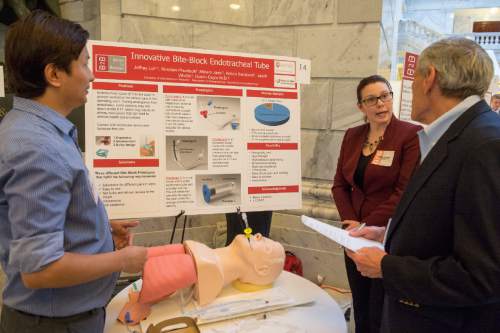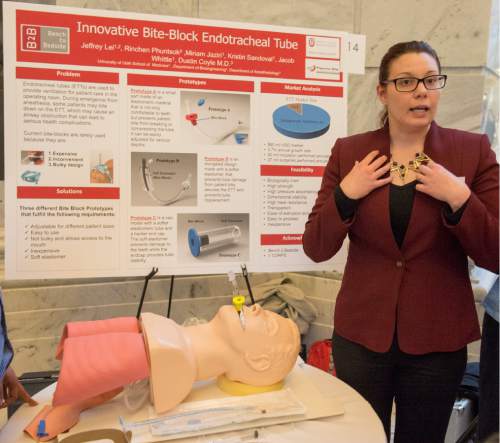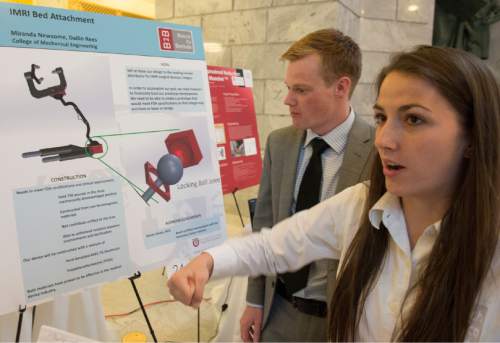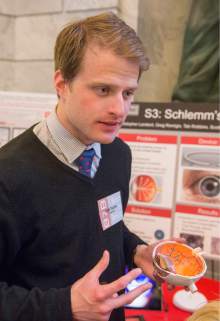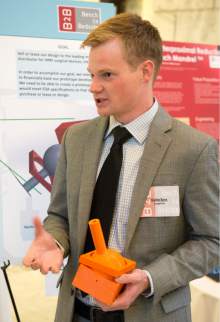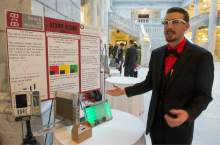This is an archived article that was published on sltrib.com in 2015, and information in the article may be outdated. It is provided only for personal research purposes and may not be reprinted.
When a patient is rendered unconscious for surgery, an anesthesiologist typically will pack gauze around the endotracheal breathing tube.
It's a low-tech solution for biting — and the patient still can chomp down and block the tube as the anesthesia wears off, said Dustin Coyle, a University of Utah anesthesiologist.
So Coyle posed a challenge to a five-member team of medical, engineering and business students as part of the fifth annual Bench-2-Bedside competition: Come up with a better way.
Thirty-one teams comprised of students from a range of disciplines had similar challenges as they competed for $77,000 in prize money Wednesday in the Capitol Rotunda. The money goes toward advancing prototypes into marketable medical devices. The competition is run by the U.'s Center for Medical Innovation.
The grand prize went to Cinluma, a team that came up with a heated probe that doctors can use to destroy cervical lesions before they become cancerous. The portable probe could be especially important in developing countries, where cervical cancer is the leading cause of cancer deaths among women.
The Innovative Bite-Block Endotracheal Tube was not among the 14 projects that won amounts ranging from $500 to $15,000, but the team will nonetheless pursue a patent.
Coyle, a faculty mentor, said he expects a company already in the field will be interested in licensing the team's products, which are three types of bite blocks that snap around the tubes.
"It's a very simple idea, and it protects the teeth as well," said Miriam Jaziri, a first-year medical student, as she pointed to the simple silicone clip that her teammate, Rinchen Phuntsok, a doctoral student in biomechanical engineering, printed with a 3-D printer. The clip fits around the endotracheal tube and against the patient's lips.
The bite blocks cost only about 25 cents to produce, compared to the $30 or $150 bulky blocks typically used in intensive-care units when a patient is unconscious for long periods of time, said Kristin Sandoval, a first-year medical student and team member.
The university's annual contest is unusual for the number of students who participate and the number of companies they spin off, according to John Langell, executive director of the Center for Medical Innovation.
He predicted 22 patent applications from this year's competition, bringing the total to nearly 100 over the five years Bench-2-Bedside has been staged. It typically takes five to seven years for patents to be issued, so there are only a few of those so far, Langell said.
Students own the patents if they do all the work. If faculty members contribute, the U. gets a share in the ownership.
Twenty-six companies have been spun out of Bench-2-Bedside over the first four years, and a couple are beginning to sell products and attract investor attention, Langell said.
For instance, Xenocor, which found a way to provide portable, inexpensive laparoscopy for third-world countries, just got a $500,000 venture capital investment. Xenocor is awaiting FDA approval.
Unlike other business idea competitions, like the recent Entrepreneur Challenge hosted by the U., Bench-2-Bedside participants have to research whether their products can be patented and meet U.S Food and Drug Administration requirements.
"It's more complicated," Langell said.
Law students help the teams with some of the patenting.
Among the other devices vying for investment Wednesday were the Cruiser Crutch, which puts a hook-like bottom on a traditional crutch to reduce the impact and strength required as users walk. Students on that team won the Consumers' Choice award and $5,000 to keep developing the idea.
Chic Shield, a less obtrusive and cumbersome breast pump for lactating mothers, won the global health award, worth $5,000, and the libraries, innovation and team engagement award, worth $2,000.
While the students on the team that invented the molded shield were all male, it was the wife of one of them, Daisy Phillips, who advised and, essentially, mentored the men.
Phillips had to pump breast milk while two of her babies were in an intensive-care unit, so she knows the limitations of existing devices: There's no way to be subtle when using them, and there are a lot of parts that need cleaning. Chic Shield attempts to streamline the process.
The grand-prize winning team, Cinluma, was comprised of Brian Charlesworth, Jennwood Chen, Ashley Langell, Kris Loken, Tim Pickett and Ashley Trane.
John Langell said more than 900 university students have gone through the Bench-2-Bedside medical innovation program, which lasts for seven months. Each team gets $500 to work with.
On Wednesday, he was thinking about Willem Kolff, who invented kidney dialysis and later was on the U. team that implanted an early artificial heart.
Students often go into medicine because they want to help people, but they don't always think about the impact they can have as inventors, he said.
"How do you become him (Kolff)?" Langell asked. "How do you become the inventor that affects millions and millions of people?"
Winners of the U.'s Bench-2-Bedside competition:
Grand Prize ($15,000) • Cinluma
Runners-up ($10,000) • BolusEYE and mDOT
Best medicine ($5,000) • Excisoseal
Best engineering ($5,000) • Precision Cautery
Best business ($5,000) • CDX
Global health ($5,000) • Chic Shield
Consumers' choice ($5,000) • Cruiser Crutch
Best entertainment, arts and engineering ($5,000) • BolusEYE
Best green ($5,000) • Easy Arm
Best libraries, innovation, team engagement ($2,000) • Chic Shield
Media ($500) • Pet Steps
Legacy ($2,500) • ProMD, Lightline Catheter›







